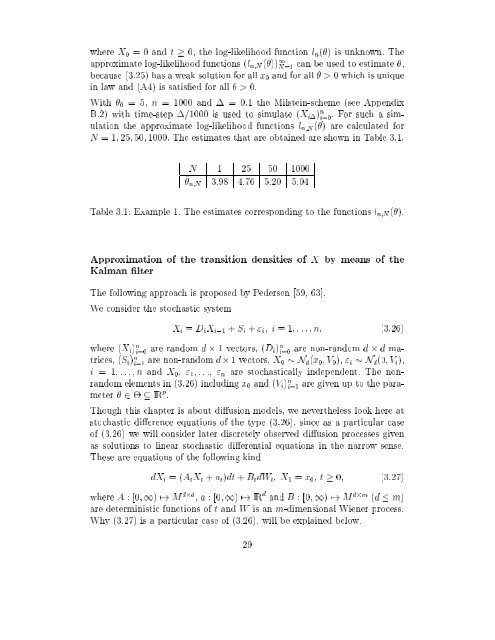Estimation in Financial Models - RiskLab
Estimation in Financial Models - RiskLab
Estimation in Financial Models - RiskLab
You also want an ePaper? Increase the reach of your titles
YUMPU automatically turns print PDFs into web optimized ePapers that Google loves.
where X 0 = 0 and t 0, the log-likelihood function l n () is unknown. The<br />
approximate log-likelihood functions (l n;N ()) 1 N=1<br />
can be used to estimate ,<br />
because (3.25) has a weak solution for all x 0 and for all >0 which is unique<br />
<strong>in</strong> law and (A4) is satised for all >0.<br />
With 0 = 5, n = 1000 and = 0:1 the Milste<strong>in</strong>-scheme (see Appendix<br />
B.2) with time-step =1000 is used to simulate (X i ) n i=0. For such a simulation<br />
the approximate log-likelihood functions l n;N () are calculated for<br />
N =1; 25; 50; 1000. The estimates that are obta<strong>in</strong>ed are shown <strong>in</strong> Table 3.1.<br />
N 1 25 50 1000<br />
^ n;N 3.98 4.76 5.20 5.04<br />
Table 3.1: Example 1. The estimates correspond<strong>in</strong>g to the functions l n;N ().<br />
Approximation of the transition densities of X by means of the<br />
Kalman lter<br />
The follow<strong>in</strong>g approach is proposed by Pedersen [59, 63].<br />
We consider the stochastic system<br />
X i = D i X i,1 + S i + " i ; i =1;:::;n; (3.26)<br />
where (X i ) n i=0<br />
are random d 1 vectors, (D i ) n i=0<br />
are non-random d d matrices,<br />
(S i ) n i=1<br />
are non-random d 1vectors, X 0 N d (x 0 ;V 0 ), " i N d (0;V i ),<br />
i = 1;:::;n and X 0 , " 1 ;:::, " n are stochastically <strong>in</strong>dependent. The nonrandom<br />
elements <strong>in</strong> (3.26) <strong>in</strong>clud<strong>in</strong>g x 0 and (V i ) n i=0<br />
are given up to the parameter<br />
2 IR p .<br />
Though this chapter is about diusion models, we nevertheless look here at<br />
stochastic dierence equations of the type (3.26), s<strong>in</strong>ce as a particular case<br />
of (3.26) we will consider later discretely observed diusion processes given<br />
as solutions to l<strong>in</strong>ear stochastic dierential equations <strong>in</strong> the narrow sense.<br />
These are equations of the follow<strong>in</strong>g k<strong>in</strong>d<br />
dX t =(A t X t + a t )dt + B t dW t ; X 0 = x 0 ; t 0; (3.27)<br />
where A :[0; 1) 7! M dd , a :[0; 1) 7! IR d and B :[0; 1) 7! M dm (d m)<br />
are determ<strong>in</strong>istic functions of t and W is an m-dimensional Wiener process.<br />
Why (3.27) is a particular case of (3.26), will be expla<strong>in</strong>ed below.<br />
29
















